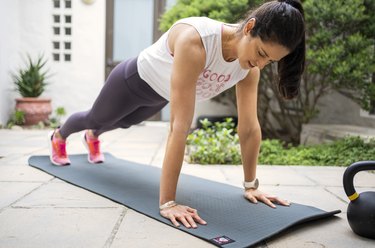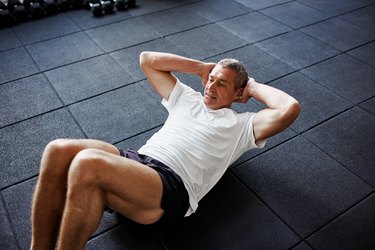
If a defined core is on your list of fitness goals, you may have wondered how long it takes to get six-pack abs.
In your quest for ab definition, it's important to understand two very important things: You already have core muscles — but they just may not be as visible as you'd like. Developing abdominal strength or muscle definition takes a while for everyone, so a little patience is needed.
Video of the Day
Video of the Day
It may take anywhere from months to a year or more, depending on your overall body fat percentage and how much of it you naturally carry around your midsection. Learn how long it takes to get six pack muscle definition and strength and how you can work toward this goal safely and efficiently.
A Quick Note About Language
We make deliberate choices about the language we use when it comes to gender. Most sources on fat loss categorize athletes into female or male groups, which is why we use the terms "women" and "men" below. All the gendered terms below are taken from their original sources.
How Long Does It Take to Get a Six Pack?
Defining the muscle in your core requires simultaneously growing the rectus abdominis muscle, or six-pack muscle, and reducing the amount of subcutaneous belly fat that sits between that muscle and the skin of your abdomen. Do both, and you'll start to see more muscle definition over time. Keep in mind that hormonal changes, bloating and water intake can all temporarily affect the day-to-day look of your body.
Sounds simple, right? Well, not exactly. First, you need to figure out exactly how much fat you need to lose. From there, you can get an approximate timeline to your six pack.
How Much Fat Do You Have to Lose to Get Abs?
For ab muscles to be visible, men need to have body fat percentages of about 6 to 13 percent and women need to have body fat percentages of about 14 to 20 percent, according to the American Council on Exercise (ACE). This is often classified as an "athlete" level of body fat (see the chart below).
Meanwhile, the average adult male's body is between 18 and 24 percent fat, and the average female's body is between 25 and 31 percent fat, according to the ACE.
If you fall into this "average" category, you'll have to drop your body fat levels to be able to see more muscle definition. If you have more or less body fat, you will have more or less to lose.
If you already have a body fat percentage that's within the above target ranges, but your abs are not as visible as you'd like, you may need to focus more on strengthening and growing your abdominal muscles for increased definition.
However, while visible abs are a common aesthetic goal, try your best to focus on fitness goals instead. Not only do these help you grow stronger but will give you an functional objective with your body.
Body Fat Percentages
Body Fat Level % | Assigned Female at Birth | Assigned Male at Birth |
|---|---|---|
Essential Fat | 10 - 13% | 2 - 5% |
Athlete | 14 - 20% | 6 - 13% |
Fitness | 21 - 24% | 14 - 17% |
Average | 25 - 31% | 18 - 24% |
Above Average |
|
|
Calculating How Much Fat You Need to Lose
To determine how many pounds of fat you need to lose to see your abs, you need to do some math.
The first step is to calculate your body fat percentage. The most accurate methods for measuring body fat include dual energy X-ray absorptiometry (DEXA) scanning and hydrostatic, or underwater, weighing. These come with hefty price tags and are difficult to access.
Other cheaper and more accessible options include specialized hand-held devices and smart scales as well as skin-fold testing. While these methods are not quite as accurate, they can be helpful in estimating body fat levels.
Once you have your body fat percentage, you can subtract that percentage from 1 and multiply that total by your current total weight in pounds to determine how many pounds of lean tissue (that's every part of your body that is not fat) you have on your frame right now.
(1 - current body fat percentage) X current body weight = current lean body weight
How to Calculate Your Current Fat Percentage
Take Jason, who weighs 170 pounds, has 20% body fat and wants to get to 13% body fat.
(1 - current body fat %) X current body weight = current lean body weight
- For Jason: (1 - 0.20) X 170 = 136 pounds current lean weight
Current lean body weight/(1 - desired body fat %) = desired body weight
- For Jason: 136/(1 - 0.13) = 156 lbs
Current body weight - goal body weight = fat-loss goal
- For Jason: 170 - 156 = 14 pounds
The result: Jason needs to lose 14 pounds of body fat to reach his desired body fat percentage of 13 percent.
Fat-Loss Timeline
Now you know how many pounds of fat you have to lose (or at least how to find that out) to reach the percentage that allows you to see your abdominal muscles. But how long will it take to lose that much weight and uncover your abs?
For healthy, sustainable fat loss, the Centers for Disease Control and Prevention recommend losing roughly 1 to 2 pounds of weight per week as a healthy rate.
So theoretically, if Jason lost 1 pound per week, he'd reach his target body fat percentage in 14 weeks. If he lost 2 per week, it would take 7 weeks.
According to Mayo Clinic, 1 pound of fat contains 3,500 calories. That means you could estimate that if, everything being equal, you burn 250 calories through exercise each day and reduce your daily calorie intake by another 250, you will create a 500-calorie daily deficit, adding up to 3,500 calories per week. Therefore, you will lose roughly 1 pound of fat per week.
However, your body doesn't work on such a neat schedule, and when you lose weight, it's rarely only fat loss. Chances are, you lose some water weight and some muscle, too. Of course, when trying to get six-pack abs, the goal is to minimize muscle loss as much as possible (more on that below).
Many additional factors affect your fat-loss rate. Genetics are a big one. Some people tend to lose weight more quickly than others. Hormones, underlying health conditions, medications you take and many other things can also speed up or slow down fat loss.
So, how long does it take to get a six-pack? You can estimate the timeline to be a minimum of the number of pounds of fat you have to lose, divided in half — but it will likely take a little longer.
Belly Fat-Loss Timeline
Sex Assigned at Birth | Current Body Fat Level | Time to Abs |
|---|---|---|
Female | 25%, goal loss of 21 lbs. | 10.5 - 21 weeks |
Female | 35%, goal loss of 45 lbs. | 22.5 - 45 weeks |
Male | 25%, goal loss of 28 lbs. | 14 - 28 weeks |
Male | 35%, goal loss of 56 lbs. | 28 - 56 weeks |
Warning
The body fat percentages required for a visible six-pack can be perfectly healthy for some people, but they are not sustainable or healthy for everyone. Listen to your body and address any concerns with your doctor.
6 Ways to Get Lean Quick
You don't have control over a lot of factors that determine how long it takes to get abs, but you can control both nutrition and exercise to get six-pack abs faster. Here are the most important guidelines to follow.
1. Create a Moderate Caloric Deficit
If your current body fat percentage is higher than your target, you need to consume fewer calories per day than you use for energy.
Still, when it comes to creating caloric deficits, bigger isn't always better. Calories contain the energy your body needs to thrive. Start by reducing your daily caloric intake by no more than 500 calories and adjust from there to help you stay in that healthy weight-loss range of 1 to 2 pounds per week.
2. Focus on Nutrient-Rich Foods
Load up on fruit, vegetables, whole grains, lean protein, low-fat dairy, eggs, beans, nuts and legumes. All of these foods contain the vitamins and minerals you need to support your workouts and fat-loss goals.
Use these whole, healthy foods to crowd out heavily refined or processed foods that contain fewer nutrients.
3. Get More Protein
To lose fat, protein is critical. When you're cutting calories, it encourages the body to maintain, or even gain, muscle. That's a win-win for revealing six-pack abs.
Also, eating protein can help you maintain muscle mass. Wondering how long it takes to lose abs? If you're taking a break from exercise, eating enough protein can actually help you preserve muscle mass and delay atrophy a little longer, according to Harvard Health Publishing.
4. Perform High-Intensity Cardio
Vigorous cardio burns more fat in less time compared with long, slow cardio. Plus, high-intensity exercise comes with an afterburn effect, according to the ACE, meaning your body keeps burning calories at a higher rate in the hours following your workout session.
To gauge your exercise intensity, use rate of perceived exertion, or the RPE scale.
5. Strength Train with Heavy, Compound Exercises
The more muscle you have, the faster you'll burn fat, which is why strength training is so important to getting defined abs.
Build muscle fast by choosing multi-joint exercises, such as squats, deadlifts and rows, over single-joint isolation exercises like biceps curls. By recruiting more muscles with every rep, these compound exercises build more muscle, burn more calories while you're doing them and encourage the afterburn effect for increased fat loss.
Focus on working at an intensity (or using weights) that allows you to maintain proper form while feeling challenging.
6. Use Ab Exercises to Build Muscle, Not Burn Fat
Dedicated core exercises and workouts can help grow your abdominal muscles, but they will not make a large difference in your fat-loss progress because spot reduction is a myth.
Incorporate a few ab exercises into each workout to build your abdominal muscles, which you will uncover with the rest of your exercise and nutrition plan for abs.
How Long Does It Take to Build Abs?
Building muscle isn't a quick process and there isn't an exact timeline. Muscle building is person-specific, so there's limited research on how long it takes muscles (including your abs) to grow.
A December 2019 study in Environmental Research and Public Health suggests you probably won't see much muscle growth before 6 weeks of consistent training. Although newbies may see noticeable growth early on, this is probably just the result of standard muscle damage and swelling that happens with new exercise.
Bottom line: There's no clear timeline. Just stay consistent!
The Best Ab Exercises and Workouts
- American Council on Exercise: "What Are the Guidelines for Percentage of Body Fat Loss?"
- Centers for Disease Control and Prevention: "Losing Weight"
- Mayo Clinic: "Counting Calories: "Get Back to Weight-Loss Basics"
- American Council on Exercise: "7 Things to Know About Excess Post-exercise Oxygen Consumption (EPOC)"
- Harvard Health Publishing: "Preserve Your Muscle Mass"
- Environmental Research and Public Health: "Maximizing Muscle Hypertrophy: A Systematic Review of Advanced Resistance Training Techniques and Methods"


